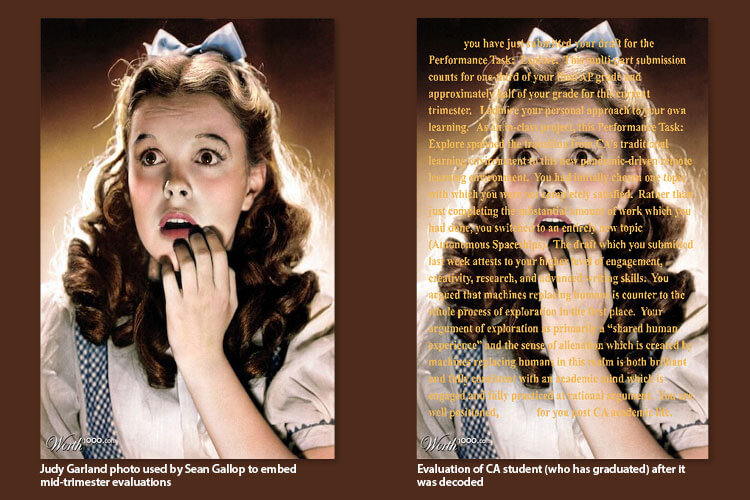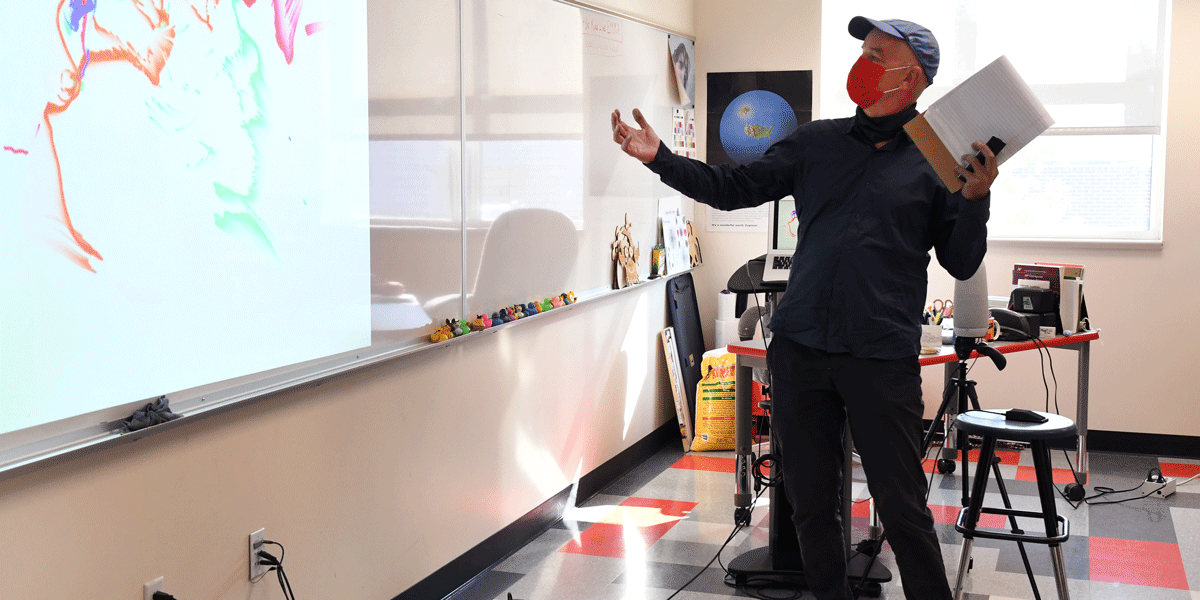Colorado Academy Senior Miriam Rojo Gutierrez was pleased when she read her mid-trimester evaluation remarks in AP Computer Science Principles. Her teacher, Sean Gallop, had positive things to say about her work in the class.
“It’s so nice to hear that from a teacher,” Rojo Gutierrez says. “It reflects on how much I have improved through the years.”
Had she not mastered the material in this class, however, Gutierrez could not have even read her teacher’s comments. That’s because Gallop delivered his mid-tri evaluations embedded in Judy Garland promotional photos—each student receiving invisible-to-the-eye remarks in a personalized photo.

To find out what Gallop had written, the students had to use what they had learned from his unit on steganography—the art of hiding information in photos, videos, music, and text. It’s a technique used during war and peace to secretly transmit information—information that is hiding in plain sight.
“You actually feel like you are a detective,” Rojo Gutierrez says. “That’s what has really intrigued me about this area of study.”
‘Reaching as many students as possible’
AP Computer Science Principles is the newest Advanced Placement course approved by the College Board. The students spend half their time learning programming and half studying topics of interest like cybersecurity, digital privacy, big data, digital rights, and cryptography. Last year, Gallop brought an infamous German “Enigma Machine” from World War II to campus for students to try as part of their cryptography unit. The class does not have a prerequisite, and for some students, this AP class is their first experience studying computer science.
“Computer science is important for all students for the future,” says Gallop. “This course is not necessarily for students who plan to become computer scientists. It’s a way that we can reach as many students as possible.”
Rojo Gutierrez had taken computer science when she was a Freshman, but she was nervous about enrolling in an AP course, so she went to talk to Gallop.
“He asked me, ‘Why wouldn’t you give it a try?’” says Rojo Gutierrez. “I didn’t have any answer, so I signed up. Once you get the hang of it, everything connects nicely.”
Junior Grant Nelligan described the prospect of AP Computer Science as “scary,” but decided to take it, because he had learned some basic coding in the yearlong Performance Innovations class with Gallop during his Freshman year.
“There are a broad range of students in the class,” says Nelligan. “For those who are new to this material, Mr. Gallop gives them the time to learn at their own pace. For those who are more skilled, he makes it more difficult.”

‘Creating experiences that are authentic’
Clearly, Gallop is intrigued by steganography, and his enthusiasm is contagious. He likes to tell the story of a PhD candidate who embedded the entire works of William Shakespeare into a single photo of a tree. “It’s all there, every word,” he says. “You just have to know how to find it.”
In the class, he helps students do the finding with starter code, but they must learn to write a simple program to both encode and decode a hidden message. When mid-trimester arrives, he knows how to motivate the class. “I tell them, ‘This is exactly what I am going to say to your parents during conferences, but it’s embedded in this photo,’” he says. “They have to use the program they wrote to pull it out.”
It takes Gallop about 10 hours to write comments for 30 students in two classes, and it takes another 10 hours to hide the comments in the photos, thereby doubling the amount of work for Gallop. “It’s so worth it,” he says. “This is how I define education—creating experiences that are authentic, finding things they want to learn and know.”
Nelligan says he “loves this class.”
“It’s super interesting,” he says. “I never knew you could do this, and Mr. Gallop also showed us how steganography is used in the bigger world.”
Rojo Gutierrez can recite some of her decoded mid-tri remarks by heart. “Mr. Gallop wrote, ‘I’m really glad you decided to join this class. You have made a lot of progress.’” She agrees with his point about making progress. In Middle School, she was not particularly interested in computer science. Now she is thinking about studying computer science and psychology in college.
There may have been another unintended learning experience that came out of this exercise. Both Nelligan and Rojo Gutierrez confess that only one student in the class knew who Judy Garland was—and now, thanks to the wizardry of steganography, they all know.
